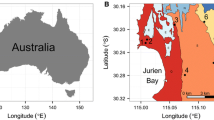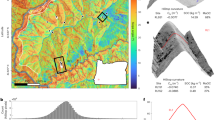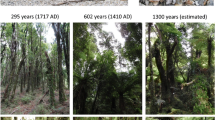Abstract
Aerial photographs, maps and optically stimulated luminescence dates were combined with existing soil data to construct high resolution chronosequences of soil development over 140 years at a temperate Atlantic UK dune system. Since soil formation had progressed for varying duration under different climate and nitrogen deposition regimes, it was possible to infer their relative influence on soil development compared with location-specific variables such as soil pH, slope and distance to the sea. Results suggest that soil development followed a sigmoid curve. Soil development was faster in wet than in dry dune habitats. In dry dunes, rates were greater than in the literature: they increased with increasing temperature and nitrogen deposition and decreased with increasing summer gales. The combination explained 62% of the variation. Co-correlation meant that effects of nitrogen deposition could not be differentiated from temperature. In wet dune habitats rates increased with temperature and decreased with gales. The combination explained only 23% of the variation; surprisingly, rainfall was not significant. Effects of location-specific variables were not significant in either habitat type. Nitrogen accumulation was faster in wet than dry dune habitats, averaging 43 kg N ha−1 per year overall. Nitrogen accumulation greatly exceeded inputs from atmospheric deposition, suggesting rates of input for biological N fixation are 10–60 kg N ha−1 per year. Recent climate and/or nitrogen deposition regimes may have accelerated soil development compared with past rates. These data suggest the importance of changing climate on soil development rates and highlight the contribution of biological N fixation in early successional systems.







Similar content being viewed by others
Abbreviations
- OSL:
-
optically stimulated luminescence
- %LOI:
-
percentage loss on ignition
- PCA:
-
principal components analysis
References
Bailey SD (2004) A geophysical and geochronological assessment of coastal dune evolution at Aberffraw, North Wales. PhD thesis, Birkbeck College, University of London
Ball DF (1964) Loss-on-ignition as an estimate of organic matter and organic carbon in non-calcareous soils. J Soil Sci 15:84–92
Berendse F (1998) Effects of dominant plant species on soils during succession in nutrient-poor ecosystems. Biogeochemistry 42:73–88
Berendse F, Lammerts EJ, Olff H (1998) Soil organic matter accumulation and its implications for nitrogen mineralization and plant species composition during succession in coastal dune slacks. Plant Ecol 137:71–78
Berg MP, Kniese JP, Zoomer R, Verhoef HA (1998) Long-term decomposition of successive organic strata in a nitrogen saturated Scots pine forest soil. For Ecol Manag 107:159–172
Boorman LA (1989) The grazing of British sand dune vegetation. Proc R Soc Edinb 96B:75–88
Crocker RL, Major J (1955) Soil development in relation to vegetation and surface age at Glacier Bay, Alaska. J Ecol 43:427–448
Emmett BA (ed) (2007) Effects of eutrophication and acidification on terrestrial ecosystems. Final report to UK Department of Environment, Farming and Rural Affairs. CEH, Bangor
Ernst WHO, Slings QL, Nelissen HJM (1996) Pedogenesis in coastal wet dune slacks after sod-cutting in relation to revegetation. Plant Soil 180:219–230
Fowler D, O’Donoghue M, Muller JBA, Smith RI, Dragosits U, Skiba U, Sutton MA, Brimblecombe P (2004) A chronology of nitrogen deposition in the UK between 1900 and 2000. Water Air Soil Pollut Focus 4:9–23
Frederiksen L, Kollmann J, Vestergaard P, Bruun HH (2006) A multivariate approach to plant community distribution in the coastal dune zonation of NW Denmark. Phytocoenologia 36:321–342
Gerlach A, Albers EA, Broedlin W (1994) Development of the nitrogen cycle in the soils of a coastal dune succession. Acta Bot Neerl 43:189–203
Grootjans AP, Ernst WHO, Stuyfzand PJ (1998) European dune slacks: strong interactions of biology, pedogenesis and hydrology. Trends Ecol Evol 13:96–100
Jones MLM, Hayes F, Brittain SA, Haria S, Williams PD, Ashenden TW, Norris DA, Reynolds B (2002) Changing nutrient budgets of sand dunes: consequences for the nature conservation interest and dune management. 2. Field survey. Contract Report September 2002. CCW Contract no: FC 73-01-347. CEH project no. C01919, pp 1–70. Centre for Ecology and Hydrology, Bangor
Jones MLM, Wallace HL, Norris D, Brittain SA, Haria S, Jones RE, Rhind PM, Reynolds BR, Emmett BA (2004) Changes in vegetation and soil characteristics in coastal sand dunes along a gradient of atmospheric nitrogen deposition. Plant Biol 6:598–605
Jones MLM, Pilkington MG, Healey M, Norris DA, Brittain SA, Tang YS, Reynolds B (2005) Determining a nitrogen budget for Merthyr Mawr sand dune system. Final report for Countryside Council for Wales. CEH project no. C02352NEW, CCW contract no. FC 72-02-59, May 2005
Jones MLM, Reynolds B, Brittain SA, Norris DA, Rhind PM, Jones RE (2006) Complex hydrological controls on wet dune slacks: the importance of local variability. Sci Total Environ 372:266–277
Jones MLM, Sowerby A, Wallace HA (2007) Better understanding of soil resources—dune stabilisation and rates of soil development on Welsh dune systems. Final Report to Countryside Council for Wales, March 2007, CEH, Bangor
Knops JMH, Tilman D (2000) Dynamics of soil nitrogen and carbon accumulation for 61 years after agricultural abandonment. Ecology 81:88–98
Kooijman AM, Besse M (2002) The higher availability of N and P in lime-poor than in lime-rich coastal dunes in The Netherlands. J Ecol 90:394–403
Kooijman AM, Dopheide JCR, Sevink J, Takken I, Verstraten JM (1998) Nutrient limitations and their implications on the effects of atmospheric deposition in coastal dunes; lime-poor and lime-rich sites in The Netherlands. J Ecol 86:511–526
Kumler ML (1997) Nitrogen fixation in dry coastal ecosystems. In: Van der Maarel E (eds) Ecosystems of the world 2c. Dry coastal ecosystems. General aspects. Elsevier, Amsterdam
Lammerts EJ, Pegtel DM, Grootjans AP, van der Veen A (1999) Nutrient limitation and vegetation changes in a coastal dune slack. J Veg Sci 10:111–122
Luo YQ, Hui DF, Zhang DQ (2006) Elevated CO2 stimulates net accumulations of carbon and nitrogen in land ecosystems: a meta-analysis. Ecology 87:53–63
MAFF (1986) The analysis of agricultural materials. MAFF/ADAS reference book 427. HMSO, London
Malloch AJC (1998) A computer program to aid the assignment of vegetation data to the communities and subcommunities of the National Vegetation Classification. University of Lancaster, UK
McLachlan A, van der Merwe D (1991) Litter decomposition in a coastal dune slack. J Coast Res 7:107–112
McLaren RG, Cameron KC (1990) Soil science. An introduction to the properties and management of New Zealand soils. Oxford University Press, Auckland
Mohd-Said MN (1999) Effects of anthropogenic nitrogen inputs on dune grassland. PhD thesis, University of Wales, Bangor
Nemergut DR, Anderson SP, Cleveland CC, Martin AP, Miller AE, Seimon A, Schmidt SK (2007) Microbial community succession in an unvegetated, recently deglaciated soil. Microbial Ecol 53:110–122
Olff H, Huisman J, Vantooren BF (1993) Species dynamics and nutrient accumulation during early primary succession in coastal sand dunes. J Ecol 81:693–706
Olson JS (1958a) Lake Michigan dune development. 2. Plants as agents and tools in geomorphology. J Geol 66:345–351
Olson JS (1958b) Rates of succession and soil changes on Southern Lake Michigan sand dunes. Bot Gaz 119:125–170
O’Neill EG, Norby RJ (1996) Litter quality and decomposition rates of foliar litter produced under CO2 enrichment. In: Koch GW, Mooney HA (eds) Carbon dioxide and terrestrial ecosystems. Academic, London
Plassmann K (2006) Effects of grazing and nitrogen deposition on sand dune systems. PhD thesis, University of Wales, Bangor
Ranwell D (1958) Movement of vegetated sand dunes at Newborough Warren, Anglesey. J Ecol 46:83–110
Ranwell D (1959) Newborough Warren, Anglesey. 1. The dune system and dune slack habitat. J Ecol 47:571–600
Rhind PM, Blackstock TH, Hardy HS, Jones RE, Sandison W (2001) The evolution of Newborough Warren dune system with particular reference to the past four decades. In Houston JA, Edmondson SE, Rooney PJ (eds) Coastal dune management. Shared experience of European Conservation Practice. Proceedings of the European Symposium Coastal Dunes of the Atlantic Biogeographical Region Southport, northwest England, September 1998. Liverpool University Press, pp 345–379
Rhind PM, Jones R, Jones MLM (2007) Confronting the threat of dune stabilization and soil development on the conservation status of sand dune systems in Wales. Proceedings of ICCD International Conference on Management and Restoration of Coastal Dunes, 3–5th October 2007, Santander, Spain
Ritchie ME, Tilman D, Knops JMH (1998) Herbivore effects on plant and nitrogen dynamics in Oak savanna. Ecology 79:165–177
Rodwell JS (ed) (2000) British plant communities, vol 5. Maritime communities and vegetation of open habitats. Cambridge University Press, Cambridge
Salisbury EJ (1922) The soils of Blakeney Point: a study of soil reaction and succession in relation to the plant covering. Ann Bot 36:391–431
Salisbury EJ (1925) Note on the edaphic succession in some dune soils with special reference to the time factor. J Ecol 13:322–328
Salisbury E (1952) Downs and dunes. Their plant life and its environment. Bell and Sons, London
Sevink J (1991) Soil development in the coastal dunes and its relation to climate. Landscape Ecol 6:49–56
Stewart WDP (1967) Transfer of biologically fixed nitrogen in a sand dune slack system. Nature 214:603–604
Stuyfzand PJ (1993) Hydrochemistry and hydrology of the Coastal Dune area of the western Netherlands. PhD thesis, Free University, Amsterdam
Syers JK, Adams JA, Walker TW (1970) Accumulation of organic matter in a chronosequence of soils developed on wind-blown sands in New Zealand. J Soil Sci 21:146–153
Talbot MR (1984) Late Pleistocene rainfall and dune building in the Sahel. Palaeoecol Afr 16:203–214
ten Harkel MJ, van Boxel JH, Verstraten JM (1998) Water and solute fluxes in dry coastal dune grasslands: the effects of grazing and increased nitrogen deposition. Plant Soil 202:1–13
Vitousek PM, Aber JD, Howarth RW, Likens GE, Matson PA, Schindler DW, Schlesinger WH, Tilman DG (1997) Human alteration of the global nitrogen cycle: sources and consequences. Ecol Appl 7:737–750
Wilson K (1960) The time factor in the development of dune soils at South Haven Peninsula, Dorset. J Ecol 48:341–359
Acknowledgement
This work was commissioned by the Countryside Council for Wales as part of its programme of research into sustaining natural beauty, wildlife and outdoor enjoyment in rural Wales and its inshore waters, and was co-funded by the UK Natural Environment Research Council.
Author information
Authors and Affiliations
Corresponding author
Additional information
Responsible Editor: N. Jim Barrow.
Rights and permissions
About this article
Cite this article
Jones, M.L.M., Sowerby, A., Williams, D.L. et al. Factors controlling soil development in sand dunes: evidence from a coastal dune soil chronosequence. Plant Soil 307, 219–234 (2008). https://doi.org/10.1007/s11104-008-9601-9
Received:
Accepted:
Published:
Issue Date:
DOI: https://doi.org/10.1007/s11104-008-9601-9




